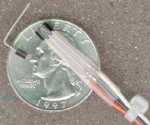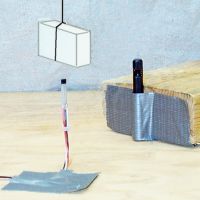
This uses a linear hall effect sensor to generate a CV to control an analog synthesizer.
Toby Paddock - July 20, 1999
The device is an
Allegro MicroSystems
A3517LUA Ratiometric Linear Hall-Effect Monolithic Sensor.
The
3517
uses a single 5V supply and the sensitivity is 5 mV/G (gauss).
Package is a 3-pin "ultra-mini-SIP".
Output with no mag field is about 1/2 supply voltage.
Full scale is rail-rail.
Specs say it will source about 1 mA and sink 10 mA.

As the military would say: "The device was tested. It was found to be effective."
I tacked some wires on it with a little heat shrink and applied 5V. A DMM on the output read about 2.47V. I could drive the output to about 50mV from the rails with a ceramic magnet. No residual offset.
Rotated it in the earth's field and measured a max difference of very roughly 4mV pk-pk. So 2mV pk. So (2mV / 5mV_per_G) 0.4 gauss measured field. Is that even close? And nope, the field is not at all flat to the ground where I am. This is way too much fun for not much work.
For general use, a buffer amp with offset and
gain controls would be A Good Thing.
Maybe offset-gain-offset.

A magnet is tied to a string as a pendulum. A magnetic sensor is held below it. As the magnet passes by, the sensor output wiggles. Also, the sensitive axis of the sensor and the N-S axis of the magnet are both horizontal. Rotation of the magnet becomes another "variable of wobbularity". Or degree of freedom, dimension, order, whatever.
In order to increase the wobbularity and to keep the swinging magnet from just lining up with the earth's field, a fixed magnet is added off to the side. Its N-S axis is vertical. The two magnets do the "chaotic system thing". This example uses only one sensor and one fixed magnet.
Suggestions: More sensors. More fixed magnets. One of the sensors or a reed switch as a trigger to gate a synth. Position 2 sensors right next to each other with the sensitive axes 90 degrees apart. They see the magnet at the same time, but the outputs are dependent on magnet rotation.
magpend1.wav (160k) Ignore the sound quality. This is a wav file of the above setup with the sensor controlling the pitch of an oscillator. Ignore the sound quality. This is just to get an idea of what the CV "waveform" is like with a reasonably small wav file. Please ignore the sound quality.
Suggestions, corrections, comments, and general abuse are more than welcome.

© 1999 Toby Paddock